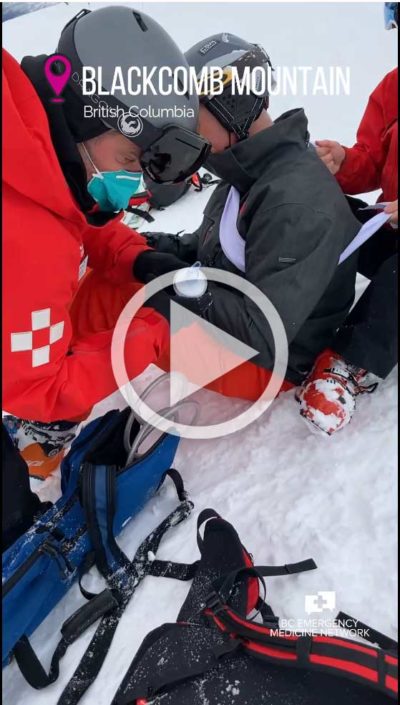I have been a volunteer ski patrol physician for 25 years. Shoulder dislocation is a very common injury.
In this short video, I demonstrate just one of the methods of shoulder reduction that we often use.
Before attempting shoulder reduction, I obtained a history from the patient about the mechanism of injury, any past history of shoulder problems (he had a remote history of fracture clavicle but no previous shoulder dislocations).
I examined both shoulders with my hand under his jacket to confirm it was definitely an anterior dislocation, and I did a quick neurovascular assessment of his left arm for any evidence of axillary, median, ulnar or radial nerve deficit.
I told him it was dislocated, that there might be associated fractures that wouldn’t preclude a reduction attempt (I didn’t name them for him but these would include Hill Sachs, Bankart, and Greater tuberosity fractures) and then I asked him if he wanted to proceed with a gentle attempt at reduction, which, if he was able to relax, would involve minimal movement and would be painless.
He consented and the reduction proceeded as it so often does. Easily and safely. Which made it much easier to sling his arm and transport him more comfortably to the clinic at the base of the mountain for further assessment and imaging.
You will notice that I actually took away the Nitrous Oxide that had been given to him by the ski patrol to help him with his pain prior to my arrival. I often do this so the patient can concentrate on what I am saying in terms of how to breathe and how to relax.
Relaxation is KEY.
If the reduction does not proceed easily and painlessly or “feels wrong” (crepitus etc), we stop, give the patient something for pain, and transport for further assessment and imaging at the clinic.
Bruce.
It is with profound sadness that Emergency Care BC shares the news of the passing of Dr. Bruce Mohr. An amazing emergency physician, colleague and friend, Dr. Mohr leaves behind a legacy of excellence in medical leadership and patient care, together with a passion for teaching and an outdoor lifestyle envied by many. Dr. Mohr made a positive impact on the Emergency community and we have all benefitted because of him.
ECBC is grateful to Dr. Mohr for all his work on behalf of colleagues and patients, including his popular and educational series of shoulder reduction procedural videos. He is and will be greatly missed.
To support Dr. Mohr’s legacy, consider giving to the Dr. Bruce Mohr Memorial Fund supporting awards for UBC students focused on emergency medicine.
COMMENTS (2)
Mulvey JM, Carson IN, Palmer KA. Closed Reduction of Anterior Shoulder Dislocations Performed by Ski Patrollers in the Alpine Prehospital Environment: A Retrospective Review Demonstrating Efficacy in a Canadian Ski Resort. Wilderness Environ Med. 2021 Dec;32(4):441-449. doi: 10.1016/j.wem.2021.07.007. Epub 2021 Oct 9. PMID: 34635430.
Excellent work!
Add public comment…



Mulvey JM, Carson IN, Palmer KA. Closed Reduction of Anterior Shoulder Dislocations Performed by Ski Patrollers in the Alpine Prehospital Environment: A Retrospective Review Demonstrating Efficacy in a Canadian Ski Resort. Wilderness Environ Med. 2021 Dec;32(4):441-449. doi: 10.1016/j.wem.2021.07.007. Epub 2021 Oct 9. PMID: 34635430.